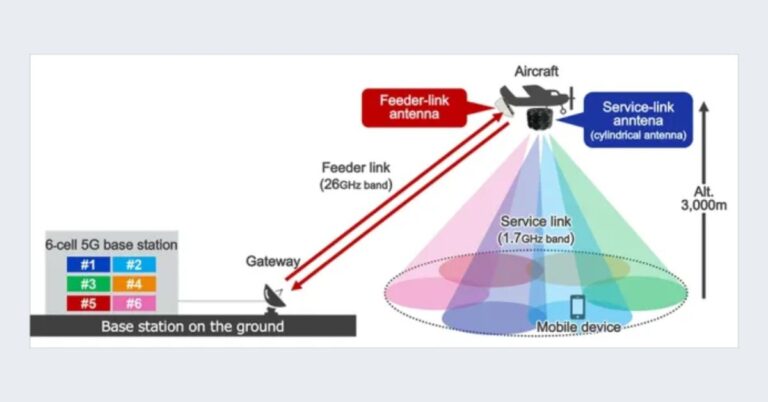SoftBank 5G HAPS payload proves multi‑cell NTN coverage
SoftBank has validated a multi‑cell, end‑to‑end 5G link via a high‑altitude platform payload, marking a concrete step toward stratospheric coverage that works with standard smartphones.
From proof‑of‑concept to pre‑commercial HAPS 5G architecture
In a June field trial over Hachijō Island, Japan, SoftBank mounted a newly developed payload on a light aircraft at 3,000 meters to emulate a High Altitude Platform Station (HAPS) operating around 20 kilometers. The system stitched a millimeter‑wave feeder link at 26 GHz from a ground gateway to the aircraft with a sub‑2 GHz service link at 1.7 GHz from the aircraft to handsets, completing an end‑to‑end path through the 5G core. This is not a repeater; the node functions as an intelligent airborne base station that integrates both feeder and service links in one payload.
HAPS trial technical advances: 6 cells, digital beamforming, Doppler correction
The payload created six fixed ground cells using digital beamforming and a cylindrical service‑link antenna, holding each cell steady even as the aircraft flew a circular pattern. The feeder‑link subsystem handled beam tracking, signal‑level compensation to counter aircraft movement, and Doppler correction. The cell footprint shifted every 60 degrees around the 360‑degree azimuth, demonstrating “footprint fixation” that keeps coverage static on the ground despite platform motion—essential for reliable mobility and handovers.
Performance results: 33 Mbps edge, low latency vs satellite
SoftBank measured an average downlink rate of roughly 33 Mbps at a point 15 kilometers from the aircraft’s center, at an 11‑degree elevation angle—geometrically equivalent to the edge of a 100‑kilometer radius cell at a 20‑kilometer HAPS altitude. That result confirms usable smartphone service at the coverage periphery, with latency and link budgets that benefit from HAPS’ proximity versus low‑Earth‑orbit satellites.
HAPS vs satellite‑to‑cell: NTN trade‑offs for terrestrial 5G
Stratospheric platforms promise a different cost‑performance envelope than direct‑to‑device satellite links, with implications for spectrum reuse, latency, and device compatibility.
Link budget, latency, and spectrum reuse with HAPS NTN
At ~20 kilometers, HAPS offers lower path loss and lower latency than orbital systems, improving indoor penetration in sub‑2 GHz bands and enabling tighter frequency reuse with multi‑cell beamforming. SoftBank’s approach uses smartphone‑native bands for the service link (here, 1.7 GHz)—a practical advantage for immediate device compatibility—while backhauling via a high‑capacity mmWave feeder link. Compared with low‑Earth‑orbit direct‑to‑device plays, HAPS can deliver wider cells with fewer Doppler dynamics and more predictable interference management, provided beams are precisely shaped and coordinated with terrestrial networks.
WRC‑23 spectrum gains for HAPS in IMT bands
International decisions at ITU WRC‑23 opened clearer avenues for HAPS operations in terrestrial mobile bands such as 700 MHz, 850 MHz, 1.7 GHz, and 2.5 GHz, subject to national implementation. That matters for operators planning to reuse existing IMT spectrum rather than relying on bespoke bands. In parallel, the HAPS Alliance continues to advocate interoperability and ecosystem alignment, while 3GPP work on non‑terrestrial networks and integrated access/backhaul informs how airborne nodes can interwork with standard RAN and core functions.
Where HAPS fits in 5G operator strategy
HAPS can serve as an elastic RAN layer that augments terrestrial coverage, especially when towers are impractical or compromised.
Coverage augmentation and disaster recovery with HAPS
Rapidly deployable stratospheric cells can restore macro coverage after disasters, blanket remote islands, or extend service across sparsely populated regions without building dense tower infrastructure. Because the service link uses bands already in many phones, subscribers can connect without special hardware.
mmWave feeder backhaul and rural broadband
The mmWave feeder link to ground gateways offers flexible backhaul where fiber is unavailable, while multi‑cell beamforming increases spectral efficiency compared with single‑beam balloons. As payload capacity scales, operators can offload traffic spikes or serve seasonal demand without permanent build‑outs.
Enterprise and government use cases for HAPS NTN
Public safety, maritime corridors, energy sites, and logistics routes could benefit from wide‑area, contiguous coverage. Temporary aerial capacity for events or mission‑critical operations becomes feasible without complex device changes, making service packaging more straightforward for B2B buyers.
Architecture guidance for CTOs and solution architects
Designing for commercial HAPS requires disciplined RAN integration, RF engineering, and operations planning.
RAN/core integration model for airborne gNodeB
Treat the HAPS payload as a gNodeB with an airborne DU/RU and a feeder‑link backhaul to ground‑based CU and 5G core. Validate mobility between terrestrial and aerial cells, including idle and connected mode, paging strategies, and measurement reporting tailored to low elevation angles. Consider placing UPF at the gateway site for latency control and traffic breakout.
Radio design trade‑offs: bands, beamforming, coexistence
Band selection drives capacity and penetration: sub‑2 GHz extends reach; mid‑band raises throughput; mmWave suits feeder backhaul. Digital beamforming with cylindrical arrays enables azimuthal sectorization; combine with null forming and spectrum‑sharing techniques to coexist with terrestrial cells—building on SoftBank’s earlier demonstrations of interference suppression and area optimization. Gateway siting, EIRP limits, and cross‑border coordination will constrain link budgets and reuse patterns.
Operational risks: endurance, airspace, gateways
Commercial viability hinges on platform endurance, power budgets, and stable station‑keeping in the lower stratosphere. Airspace approvals, weather resilience, payload thermal management, and maintenance cycles affect OPEX. Ground gateway availability and redundancy are as critical as the aerial node itself.
What’s next for SoftBank and the HAPS ecosystem
The next milestones will show whether this approach scales from a six‑cell demo to a carrier‑grade network element.
Scaling beyond six cells: capacity and resilience
Expect larger beam counts, higher spectral efficiency, and multi‑gateway architectures to boost capacity and resilience. KPIs to track include per‑cell throughput, interference leakage, handover success, and availability under platform motion.
Standards alignment: 3GPP NTN, slicing, MEC
Watch for 3GPP feature support relevant to airborne RAN, integration with network slicing and MEC, and device behavior at low elevation angles. Work within the HAPS Alliance and national regulators will shape band allocations and coexistence rules.
Commercial timelines and ecosystem partnerships
SoftBank’s trial, partially backed by Japan’s NICT Beyond 5G/6G program, suggests public‑private momentum. Platform partners, gateway vendors, and RAN suppliers will determine time‑to‑market, along with regulatory clearances for stratospheric operations.
Next steps for operators and enterprises
Organizations should start low‑risk preparations now to shorten the path from trials to service.
Targeted pilots and coverage modeling
Identify priority geographies—islands, disaster‑prone areas, long‑haul corridors—and simulate aerial cell plans, elevation angles, and in‑building propagation at 700 MHz to 2.6 GHz. Include user experience testing on mainstream devices.
Early engagement on spectrum and regulation
Map IMT band options post‑WRC‑23, establish coexistence frameworks with terrestrial macro layers, and pre‑negotiate authorizations for flight operations and gateways.
Plan architecture and operations for HAPS NTN
Define how HAPS nodes integrate with your 5G core, security, and assurance stacks; prepare mobility policies, telemetry, and incident procedures adapted to airborne assets.
Validate the HAPS business case vs satellite‑to‑cell
Compare total cost of ownership versus satellite‑to‑cell and rural macro builds, factoring SLA requirements, platform endurance, and service packaging for public safety, enterprise, and wholesale coverage augmentation.
Bottom line: SoftBank’s six‑cell HAPS payload demonstrates that carrier‑grade, smartphone‑compatible 5G from the stratosphere is technically credible; the next phase is scaling capacity, proving economics, and operationalizing at network level.








































